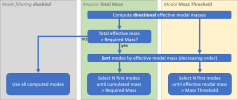Seismic loading: Mode filtering
Introduction
By default, seismic load cases are configured without mode filtering. As a consequence, all computed modes are taken into account during modal superposition of seismic load cases, which can lead to long computation times when the model is large and/or a large number of modes is requested.
Mode filtering allows to take modes into account selectively for seismic modal superposition.
By retaining only the most relevant modes, mode filtering can lead to an important speed up of computation time for modal superposition of seismic load cases, without significant loss of accuracy.
Two filtering methods are proposed in SCIA Engineer:
- Total mass: only modes with the highest modal mass ratio are taken into account for modal superposition. Modes are sorted in decreasing order of their modal mass ratio and superposed until the specified cumulated mass ratio is reached.
- Mass threshold: only modes with a modal mass ratio higher than the specified value are taken into account for modal superposition.
Most seismic design codes require, that at least 90% of the total moving mass of the structure is taken into account in the effective mass of the considered modes for each considered direction (EC-EN1998-1-1 clause 4.3.3.3.1(3), ASCE 7-10 clause 12.9.1, SIA261 clause 16.5.3.5, NZS 1170-5 clause 6.3.3...). This is covered by the Total mass filtering method.
Additionally, the Eurocode proposes two alternative criteria:
- Take into account all modes with an effective modal mass greater than 5% (EC-EN1998-1-1 clause 4.3.3.3.1(3)). This is covered by the Mass threshold filtering method.
- In case neither of the criteria described in clause 4.3.3.3.1(3) can be satisfied, clause 4.3.3.3.1(5) defines the minimum number of modes to be taken into account (not implemented in SCIA Engineer)
Calculation steps
The following steps apply only if mode filtering is enabled.
Effective modal masses
Effective modal masses are re-calculated according to the actual direction of the seismic action, given by the direction factors X, Y, Z defined in the seismic load case settings. Doing so, modes are filtered for each considered direction of the seismic action (i.e. each seismic load case) according to the corresponding effective modal masses.
The computed, direction-dependent values of the effective modal mass are listed in the dynamic load case tables in the linear calculation protocol in the column Wi/Wtot.
See here an example of an unfiltered seismic load case. 200 modes have been requested and all are taken into account for modal superposition (only a small subset is displayed below). The directional values of effective modal mass are listed in the column Wi/Wtot. The cumulated effective modal mass is also presented at the bottom of the table (93.9% in this case).
After this step, in case the Total mass method and the total effective modal mass is less than the required cumulated effective mass, then all modes are used for modal superposition, as if mode filtering were disabled.
Sorting the modes
In order to facilitate the filtering, the modes are then sorted in decreasing order of the computed values of directional effective modal mass Wi/Wtot.
Filtering according to the total effective modal mass
When the Total mass filtering method is selected, the N first modes of the sorted list are cumulated, until the specified value of cumulated effective modal mass is reached.
In unfiltered calculation, the modes are sorted in increasing order of natural frequencies. In this case, the filtered modes are presented in decreasing order of their effective modal mass. Only 11 most significant modes have been retained out of the 200, reaching a cumulated effective modal mass of 90.5%.
Also note, that the value of base shear Fx changed from 781.98 kN to 781.90 kN (difference = ~0.01%).
Filtering according to the effective modal mass threshold
When the Mass threshold filtering method is selected, the N first modes of the sorted list are cumulated, until the effective modal mass is less than the specified threshold value.
Here, again, the modes are presented in decreasing order of their effective modal mass. Only 4 most significant modes have been retained out of the 200, reaching a cumulated effective modal mass of 83.2%. All modes with an effective modal mass higher than 5% have been taken into account.
The value of base shear Fx changed from 781.98 kN to 781.00 kN (difference = ~0.1%).




